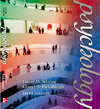Lester M. Sdorow,
Arcadia University
Cheryl A. Rickabaugh,
University of Redlands
| aggression | Verbal or physical behavior aimed at harming another person.
|
 |
 |
 |
| altruism | The helping of others without the expectation of a reward.
|
 |
 |
 |
| attitude | An evaluation, containing cognitive, emotional, and behavioral components, of an idea, event, object, or person.
|
 |
 |
 |
| bystander intervention | The act of helping someone who is in immediate need of aid.
|
 |
 |
 |
| causal attribution | The cognitive process by which we infer the causes of both our own and other people's social behavior.
|
 |
 |
 |
| cognitive dissonance theory | Leon Festinger's theory that attitude change is motivated by the desire to relieve the unpleasant state of arousal caused when one holds cognitions and/or behaviors that are inconsistent with each other.
|
 |
 |
 |
| companionate love | Love characterized by feelings of affection and commitment to a relationship with another person.
|
 |
 |
 |
| conformity | Behaving in accordance with group expectations with little or no overt pressure to do so.
|
 |
 |
 |
| deindividuation | The process by which group members become less aware of themselves as individuals and less concerned about being socially evaluated.
|
 |
 |
 |
| elaboration likelihood model | A theory of persuasion that considers the extent to which messages take a central route or a peripheral route.
|
 |
 |
 |
| foot-in-the-door technique | Increasing the likelihood that someone will comply with a request by first getting him or her to comply with a smaller one.
|
 |
 |
 |
| frustration-aggression hypothesis | The assumption that frustration causes aggression.
|
 |
 |
 |
| fundamental attribution error | The bias to attribute other people's behavior to dispositional factors.
|
 |
 |
 |
| group | A collection of two or more persons who interact and have mutual influence on each other.
|
 |
 |
 |
| groupthink | The tendency of small, cohesive groups to place unanimity ahead of critical thinking in making decisions.
|
 |
 |
 |
| negative state relief theory | The theory that we engage in prosocial behavior to relieve our own state of emotional distress at another's plight.
|
 |
 |
 |
| obedience | Following orders given by an authority.
|
 |
 |
 |
| passionate love | Love characterized by intense emotional arousal and sexual feelings.
|
 |
 |
 |
| person perception | The process of making judgments about the personal characteristics of others.
|
 |
 |
 |
| persuasion | The attempt to influence the attitudes of other people.
|
 |
 |
 |
| prejudice | A positive or negative attitude toward a person based on her or his membership in a particular group.
|
 |
 |
 |
| prosocial behavior | Behavior that helps others in need.
|
 |
 |
 |
| self-fulfilling prophecy | The tendency for one person's expectations to influence another person to behave in accordance with them.
|
 |
 |
 |
| self-perception theory | The theory that we infer our attitudes from our behavior in the same way that we infer other people's attitudes from their behavior.
|
 |
 |
 |
| self-serving bias | The tendency to make dispositional attributions for one's successes and situational attributions for one's failures.
|
 |
 |
 |
| social cognition | The process of perceiving, interpreting, and predicting social behavior.
|
 |
 |
 |
| social facilitation | The improvement in a person's task performance when in the presence of other people.
|
 |
 |
 |
| social loafing | A decrease in the individual effort exerted by group members when working together on a task.
|
 |
 |
 |
| social psychology | The field that studies how the actual, imagined, or implied presence of other people affects one another's thoughts, feelings, and behaviors.
|
 |
 |
 |
| social schema | A cognitive structure comprising the presumed characteristics of a role, an event, a person, or a group.
|
 |
 |
 |
| stereotype | A social schema that incorporates characteristics, which can be positive or negative, supposedly shared by almost all members of a group.
|



 2002 McGraw-Hill Higher Education
2002 McGraw-Hill Higher Education

 2002 McGraw-Hill Higher Education
2002 McGraw-Hill Higher Education